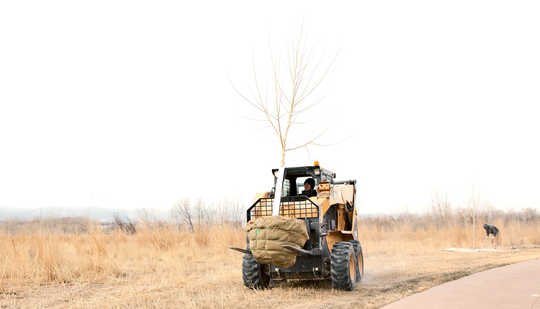
New research offers a hard link between reforestation of marginal, degraded, or abandoned agricultural land and significant benefits in water quality.
This relationship, argues Arturo Keller, a professor of environmental biogeochemistry at the University of California, Santa Barbara, lends itself toward a program that incentivizes facilities that discharge pollutants, and local farmers to plant trees for water quality credits.
The more naturally verdant an area is, the more likely it will contribute to the general health of the habitats and the organisms in and around it. Sometimes, though, tracing these qualities to specific benefits can be a challenge.
“While we have intuitively known that reforestation can be a very positive action, to date, determining how much bang for your buck you can get in terms of water quality has not been reliably quantified,” says Keller, lead author of the study in PLOS ONE and a faculty member in the Bren School of Environmental Science & Management. “Here we present an approach for identifying areas where reforestation will be most effective for improving water quality, using a widely available USDA model and data sets that anyone can access.”
Runoff and dead zones
For this study, Keller and coauthor Jessica Fox, from the Electric Power Research Institute (EPRI), focused on a section of America’s bread basket—the Ohio River Basin, more than a third of which is engaged in agriculture, and a water source for millions of people.
Importantly, the entire basin, along with five other major river basins, drains into the Gulf of Mexico via the Lower Mississippi River Basin. Nutrients—in particular, nitrogen, and phosphorus—transported via runoff mainly from farms and other agricultural operations all flow into the Gulf, creating a massive algae bloom and subsequent oxygen-free “dead zone” in the summer months that threatens or kills marine life within its boundaries.
The National Oceanic and Atmospheric Administration has predicted that the dead zone this summer could encompass a 7,829-square-mile area, one of the largest Gulf of Mexico dead zones on record.
Marginal croplands
According to the study, marginal croplands—lands with low agricultural value due to conditions such as poor soil quality, inadequate water supply, and slopes that render farming difficult—when planted with trees could be used not only to store carbon, but also to substantially reduce the movement of nitrogen, phosphorus, and sediments from land to streams and rivers.
“Trees retain soil and sediments almost completely, compared to open fields, and take up the available nitrogen and phosphorus, as well as store carbon,” says Keller, whose primary expertise lies in water quality management at the watershed level and the fate and transport of pollutants in the environment. “Quantifying these effects can now be used to give tradable credits for improving water quality.”
Additionally, according to Keller, reforestation of marginal croplands also increases biodiversity, provides habitat, and can be used economically by sustainably harvesting the timber—all without sacrificing prime agricultural value. Ideal candidates for reforestation are croplands on hill slopes that have poor soil infiltration, yet are close to a receiving water body.
Reforestation’s payoffs
The Ohio River Basin is also the location of the world’s largest water quality trading program. Administered by EPRI, the Ohio River Basin Water Quality Trading Project is a market-based approach to achieving better water quality by issuing permits to discharging facilities and requiring them to meet nutrient limits. Facilities can earn credit for these permits by paying local farmers to employ practices such as reducing fertilizer use, preventing manure from washing into streams, or planting trees by streams to help reduce runoff. The nutrient reductions can be used as credits to help the facilities meet permit requirements.
According to the study, approximately 10 percent of the current cropland in the Ohio River Basin region was identified as a high priority for reforestation.
“If this area was converted from marginal cropland to healthy forests, there would be the potential to avoid 60 million kilograms of nitrogen and two million kilograms of phosphorus from reaching the streams and rivers of the northern Ohio River Basin,” Keller says. “That’s on the order of a 12 percent decrease in total nitrogen, and a 5 percent decrease for total phosphorus for the entire basin, which drains to the Gulf of Mexico.”
While the results might differ for projects with varying local conditions, the potential for reducing nutrient loading demonstrated in the study, the ancillary benefits to the environment and economy, and the low impact to prime agricultural cropland together make this approach worth considering for managing water quality in waterways throughout the world, he says.
Source: UC Santa Barbara
Related Books
Drawdown: The Most Comprehensive Plan Ever Proposed to Reverse Global Warming
by Paul Hawken and Tom Steyer In the face of widespread fear and apathy, an international coalition of researchers, professionals, and scientists have come together to offer a set of realistic and bold solutions to climate change. One hundred techniques and practices are described here—some are well known; some you may have never heard of. They range from clean energy to educating girls in lower-income countries to land use practices that pull carbon out of the air. The solutions exist, are economically viable, and communities throughout the world are currently enacting them with skill and determination. Available On Amazon
In the face of widespread fear and apathy, an international coalition of researchers, professionals, and scientists have come together to offer a set of realistic and bold solutions to climate change. One hundred techniques and practices are described here—some are well known; some you may have never heard of. They range from clean energy to educating girls in lower-income countries to land use practices that pull carbon out of the air. The solutions exist, are economically viable, and communities throughout the world are currently enacting them with skill and determination. Available On Amazon
Designing Climate Solutions: A Policy Guide for Low-Carbon Energy
by Hal Harvey, Robbie Orvis, Jeffrey Rissman With the effects of climate change already upon us, the need to cut global greenhouse gas emissions is nothing less than urgent. It’s a daunting challenge, but the technologies and strategies to meet it exist today. A small set of energy policies, designed and implemented well, can put us on the path to a low carbon future. Energy systems are large and complex, so energy policy must be focused and cost-effective. One-size-fits-all approaches simply won’t get the job done. Policymakers need a clear, comprehensive resource that outlines the energy policies that will have the biggest impact on our climate future, and describes how to design these policies well. Available On Amazon
With the effects of climate change already upon us, the need to cut global greenhouse gas emissions is nothing less than urgent. It’s a daunting challenge, but the technologies and strategies to meet it exist today. A small set of energy policies, designed and implemented well, can put us on the path to a low carbon future. Energy systems are large and complex, so energy policy must be focused and cost-effective. One-size-fits-all approaches simply won’t get the job done. Policymakers need a clear, comprehensive resource that outlines the energy policies that will have the biggest impact on our climate future, and describes how to design these policies well. Available On Amazon
This Changes Everything: Capitalism vs. The Climate
by Naomi Klein In This Changes Everything Naomi Klein argues that climate change isn’t just another issue to be neatly filed between taxes and health care. It’s an alarm that calls us to fix an economic system that is already failing us in many ways. Klein meticulously builds the case for how massively reducing our greenhouse emissions is our best chance to simultaneously reduce gaping inequalities, re-imagine our broken democracies, and rebuild our gutted local economies. She exposes the ideological desperation of the climate-change deniers, the messianic delusions of the would-be geoengineers, and the tragic defeatism of too many mainstream green initiatives. And she demonstrates precisely why the market has not—and cannot—fix the climate crisis but will instead make things worse, with ever more extreme and ecologically damaging extraction methods, accompanied by rampant disaster capitalism. Available On Amazon
In This Changes Everything Naomi Klein argues that climate change isn’t just another issue to be neatly filed between taxes and health care. It’s an alarm that calls us to fix an economic system that is already failing us in many ways. Klein meticulously builds the case for how massively reducing our greenhouse emissions is our best chance to simultaneously reduce gaping inequalities, re-imagine our broken democracies, and rebuild our gutted local economies. She exposes the ideological desperation of the climate-change deniers, the messianic delusions of the would-be geoengineers, and the tragic defeatism of too many mainstream green initiatives. And she demonstrates precisely why the market has not—and cannot—fix the climate crisis but will instead make things worse, with ever more extreme and ecologically damaging extraction methods, accompanied by rampant disaster capitalism. Available On Amazon
From The Publisher:
Purchases on Amazon go to defray the cost of bringing you InnerSelf.comelf.com, MightyNatural.com, and ClimateImpactNews.com at no cost and without advertisers that track your browsing habits. Even if you click on a link but don't buy these selected products, anything else you buy in that same visit on Amazon pays us a small commission. There is no additional cost to you, so please contribute to the effort. You can also use this link to use to Amazon at any time so you can help support our efforts.




























